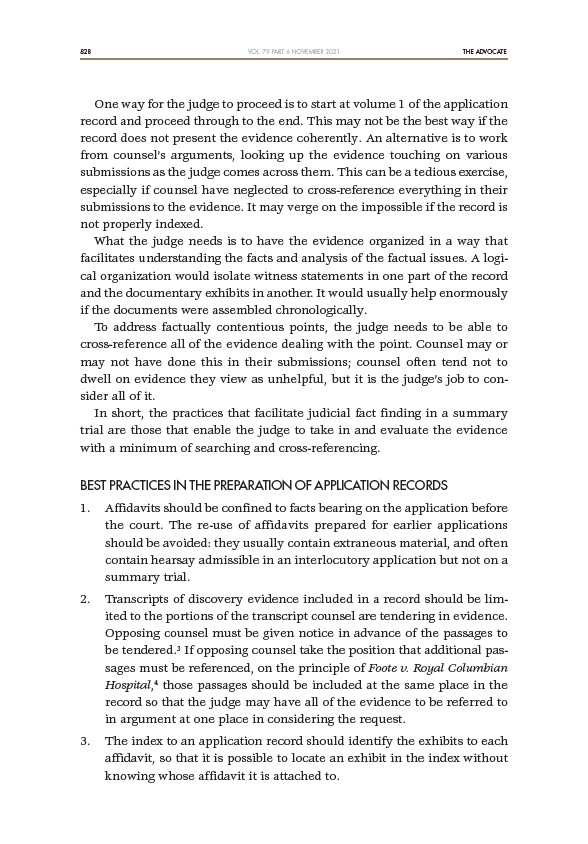
828 THE ADVOCATE
VOL. 79 PART 6 NOVEMBER 2021
One way for the judge to proceed is to start at volume 1 of the application
record and proceed through to the end. This may not be the best way if the
record does not present the evidence coherently. An alternative is to work
from counsel’s arguments, looking up the evidence touching on various
submissions as the judge comes across them. This can be a tedious exercise,
especially if counsel have neglected to cross-reference everything in their
submissions to the evidence. It may verge on the impossible if the record is
not properly indexed.
What the judge needs is to have the evidence organized in a way that
facilitates understanding the facts and analysis of the factual issues. A logical
organization would isolate witness statements in one part of the record
and the documentary exhibits in another. It would usually help enormously
if the documents were assembled chronologically.
To address factually contentious points, the judge needs to be able to
cross-reference all of the evidence dealing with the point. Counsel may or
may not have done this in their submissions; counsel often tend not to
dwell on evidence they view as unhelpful, but it is the judge’s job to consider
all of it.
In short, the practices that facilitate judicial fact finding in a summary
trial are those that enable the judge to take in and evaluate the evidence
with a minimum of searching and cross-referencing.
BEST PRACTICES IN THE PREPARATION OF APPLICATION RECORDS
1. Affidavits should be confined to facts bearing on the application before
the court. The re-use of affidavits prepared for earlier applications
should be avoided: they usually contain extraneous material, and often
contain hearsay admissible in an interlocutory application but not on a
summary trial.
2. Transcripts of discovery evidence included in a record should be limited
to the portions of the transcript counsel are tendering in evidence.
Opposing counsel must be given notice in advance of the passages to
be tendered.3 If opposing counsel take the position that additional passages
must be referenced, on the principle of Foote v. Royal Columbian
Hospital,4 those passages should be included at the same place in the
record so that the judge may have all of the evidence to be referred to
in argument at one place in considering the request.
3. The index to an application record should identify the exhibits to each
affidavit, so that it is possible to locate an exhibit in the index without
knowing whose affidavit it is attached to.